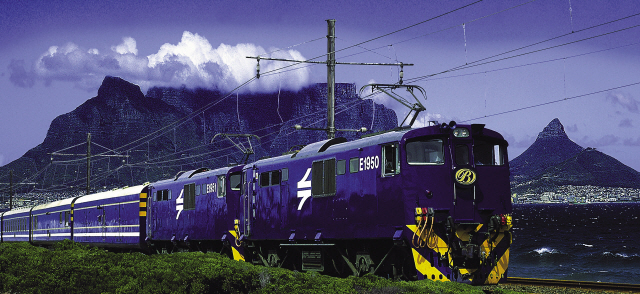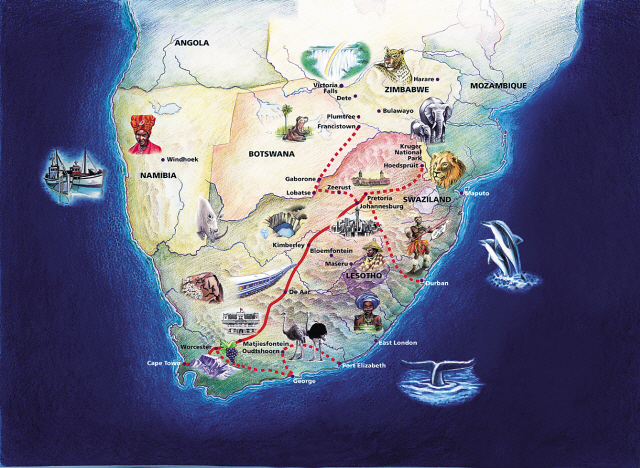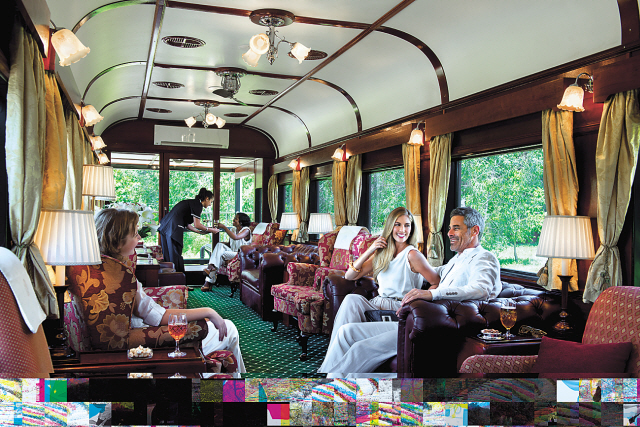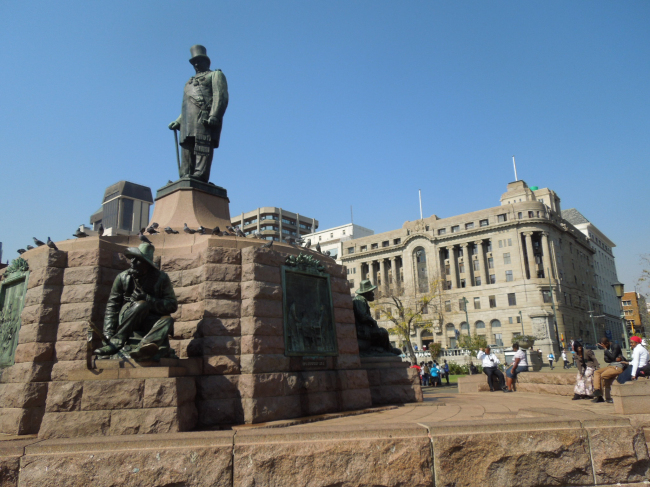Wining and dining on the African railway
Luxury rail journeys offer an unforgettable way to experience the tastes, stunning landscape of South Africa
By Korea HeraldPublished : June 14, 2013 - 19:53

CAPE TOWN ― The landscape transformed as we neared Cape Town. Mountainous scrubland that could have been plucked from a Hollywood Western gave way to the vineyards of Hex River Valley, the source of 20 percent of South Africa’s wine production.
Copper peaks, ringed by low-hanging clouds, soared above endless vineyards turned red and gold by the South African autumn. Inside our dining car, we drank the fruits of the region in the form of a dry Thelema Riesling, recommended by our waiter to accompany our Sunday lunch. To this passing scene, we dined on traditional South African Bobotie, a dish of spiced ground beef with a beaten egg topping, grilled prawn skewers, Drunken Pecornio cheese and melkart, a local milk-based tart.
On Friday our group of international journalists had begun the 1,600-kilometer trip from Pretoria to Cape Town with Rovos Rail, the “world’s most luxurious train.”
South Africa, with its vast cinematic landscape, holds special appeal for the unhurried traveler who appreciates a journey for journey’s sake, experienced in utmost comfort.
Copper peaks, ringed by low-hanging clouds, soared above endless vineyards turned red and gold by the South African autumn. Inside our dining car, we drank the fruits of the region in the form of a dry Thelema Riesling, recommended by our waiter to accompany our Sunday lunch. To this passing scene, we dined on traditional South African Bobotie, a dish of spiced ground beef with a beaten egg topping, grilled prawn skewers, Drunken Pecornio cheese and melkart, a local milk-based tart.
On Friday our group of international journalists had begun the 1,600-kilometer trip from Pretoria to Cape Town with Rovos Rail, the “world’s most luxurious train.”
South Africa, with its vast cinematic landscape, holds special appeal for the unhurried traveler who appreciates a journey for journey’s sake, experienced in utmost comfort.

The history of luxury rail travel in South Africa is accordingly rich. The first steam engine in the country ran in 1860, but the discovery of gold and diamonds near the end of the 19th century saw a rail boom. Reflecting this new wealth, the Union Express and Union Limited, featuring comforts like hot water on tap and, later, air conditioning, debuted in the 1920s. From these trains evolved the state-run Blue Train, christened in 1946, which travels the Pretoria-Cape Town route.
Rovos draws heavily on this sense of history, operating beautifully restored steam engines and carriages across South Africa and neighboring countries. The Pretoria-Cape Town route takes 48 hours, mostly due to a number of extended stops and the train’s leisurely maximum clip of 60 kilometers per hour. But the brainchild of entrepreneur Rohan Vos is not concerned with speed. The real aim is to transport a generation that has “lost the art of travel” to a different era.
“In our grandfathers’ day, it was not about the destination as it is now,” sales manager Edward Mitchell said during a tour of the company’s rail yard and workshop.
Rovos passengers will appreciate this sentiment, as upon boarding, it is clear that the private company’s claims of unrivaled luxury are not made lightly. Each passenger is assigned a personal butler, on call 24/7 to attend to every whim. Passengers choose from three types of suites ― the most luxurious of which, the Royal suite, even comes with a bathtub.

Rovos builds all its interiors and furniture itself, and this shines through in the decor throughout. Our Deluxe suite was elegantly furnished and surprisingly spacious, including a generous bed, desk, shower and even a minibar, which is stocked as you please for no extra charge.
Passengers also dine well. A gong summoned us to the dining car for every meal. The food ranged from good to exceptional. Velvety soft scallops with a lemon-infused hollandaise sauce, braised lamb and a decadently rich chocolate fondant were all especially delicious.
Having taken Rovos to Cape Town, we returned to Pretoria by the Blue Train, so called because of the color of the engine and carriages. With a history of transporting kings and presidents, this is a train that prides itself as an institution. Numerous details, from the “B” logo on the pen at your cabin’s writing desk to the chocolates on your pillow, reinforce the Blue Train identity throughout your journey.
Where Rovos journeys back in time, the Blue Train, though certainly high on nostalgia, is a more modern affair. The ride as we zipped along at a relatively brisk 90 kph was nothing but smooth. The greater top speed and fewer stops meant we did the cross-country route in 24 hours, every minute of which felt like a pampering.
While the Blue Train is a gateway to new experiences, the management also wants travelers to feel at home. Even half a world away from their country, Korean travelers may encounter a touch of the familiar.
“Of late we are seeing quite a lot of Koreans,” said train manager Philani Ndlela. “We are encouraging our staff members to learn different languages because of our clientele base we have on the Blue Train. For starters, some of them (are getting) Japanese lessons, we are going to do Chinese, next Portuguese and then Korean. … There’s nothing as wonderful to find that, ‘Wow, I am on the Blue Train and they can understand exactly want I want.’”
While the joy is in the journey, both trains make extended stops along the way. At the old diamond-mining town of Kimberly, passengers are introduced to the Big Hole, a depleted diamond mine. Dug more than 700 feet into the earth by hand, the hole is carpeted with a turquoise lake the size of eight football fields. Next stop is Matjiesfontein, a quaint village outside Cape Town that appears stuck in a Victorian time warp.
Back on board, there was nothing more enjoyable than to watch the African plains zip by, with the frenzy of Seoul half a world away. It was hard to imagine many other journeys leaving one so sad at the thought of reaching one’s destination.
By John Power (john.power@heraldcorp.com)
Tickets on Rovos Rail for Pretoria-Cape Town begin at 13,600 rand ($1,335) for the Pullman Suite. All food, beverages and service are included. The train departs from Pretoria 3-6 times a month, depending on the season. More information can be found at www.rovos.com.
The Blue Train begins at 12,280 rand per person sharing the Deluxe Double Suite, and 15,155 rand in high season. All food, beverages and service are included, apart from French Champagne, caviar and external phone calls. The train departs from Pretoria 3-5 times a month. More information can be found at www.bluetrain.co.za.
Pretoria and Cape Town: A brief tale of two cities
South Africa’s administrative capital of Pretoria is bound to feature early on in the itinerary of many visitors. Packed with history, the city encapsulates the striking clash of African and colonial European cultures that defines South Africa.
We checked in at the cozy but upscale 131 Herbert Baker, situated on a street named after the same English architect, before enjoying a hearty steak lunch at nearby Blue Cane Restaurant, named after the national bird that resides in the adjacent Austin Roberts Bird Sanctuary.

Appetites sated, we headed to Union Buildings, the seat of government and the site of Nelson Mandela’s historic swearing in as South Africa’s first democratically elected president. The buildings, designed by Baker using Edwardian and Dutch influences and completed in 1913, are closed to visitors, but their tiered gardens make for a pleasant walk. From here, we could take in a wonderful view of the Pretoria skyline, an uneven cluster of pinks, tans and blue-grays against a backdrop of sloping hills.
Just outside the city, we learned about an episode of Afrikaans history at the Voortrekker Monument. The distinctive, Egyptian-influenced building is dedicated to the Battle of Blood River in 1838, in which 400 Afrikaners fought off 2,000 Zulus without losing a single man.
Then we traveled to Church Square, the historic city center, where we soaked in the lives of everyday South Africans. As lawyers in full gowns hurried to lunch, dozens of other locals lay sprawled on the grass enjoying the sun. The square has a wealth of colonial buildings, including the old parliament building and the court that convicted Nelson Mandela of treason, sending him to jail for the next 27 years. At the center of the square stands a statue of Paul Kruger, the last president of the South African Republic, one of the last Boer Republics. Just off the square is Cafe Riche, Pretoria’s oldest pub.
Cape Town, South Africa’s legislative capital and the country’s tourism heart, is a city of more European sensibilities, reflecting waves of Dutch, English, French, German and Portuguese immigration.
We stayed at the colorfully modern African Pride 15 on Orange Hotel, in the imposing shadow of Table Mountain. Just a few minutes’ walk away is Company’s Garden, a park founded by early European settlers and home to a national library, gallery and museum. As we strolled through the beautifully tended grounds, squirrels so tame they’d eat from your hand scurried at our feet.
Cape Town is renowned for its natural beauty, and a trip out of the city is a must. On a gloriously sunny afternoon, we took the Southern Line train to Kalk Bay, a seaside village crammed with craft and antique shops. The red-brick trading post was especially charming, selling all manner of antiques and knickknacks from bygone eras.
From there we took the train to Simon’s Town, home to the South African Navy and the last village before the Cape of Good Hope, the most southwesterly point of Africa. From the lighthouse at nearby Cape Point we took in the view of the vast expanse of the Atlantic Ocean, a truly awe-inspiring sight.
By John Power (john.power@heraldcorp.com)
-
Articles by Korea Herald




![[Music in drama] Rekindle a love that slipped through your fingers](http://res.heraldm.com/phpwas/restmb_idxmake.php?idx=644&simg=/content/image/2024/05/01/20240501050484_0.jpg&u=20240501151646)

![[New faces of Assembly] Architect behind ‘audacious initiative’ believes in denuclearized North Korea](http://res.heraldm.com/phpwas/restmb_idxmake.php?idx=644&simg=/content/image/2024/05/01/20240501050627_0.jpg&u=20240502093000)




![[KH Explains] Will alternative trading platform shake up Korean stock market?](http://res.heraldm.com/phpwas/restmb_idxmake.php?idx=644&simg=/content/image/2024/05/01/20240501050557_0.jpg&u=20240501161906)







![[Today’s K-pop] Stray Kids go gold in US with ‘Maniac’](http://res.heraldm.com/phpwas/restmb_idxmake.php?idx=642&simg=/content/image/2024/05/02/20240502050771_0.jpg&u=)